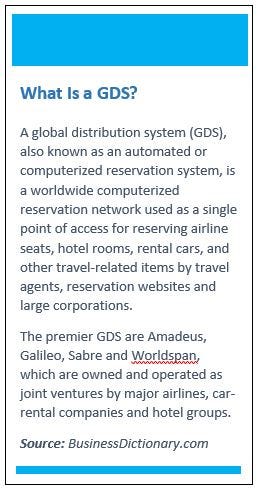Using GDS Technology in Self-Storage
Self-storage operators can capitalize on global distribution systems (GDS) to reduce costs while accommodating consumers’ desire for automation. Find out how a GDS works and how it can help you maintain balance between technology and customer service.
American businesses are investing more and more in technology in response to today’s discerning consumers, who bring a new level of expectation to everything they do, from how they shop to how they make purchase decisions to how they pay. Companies that rely on outdated practices will fail to remain competitive. For example, in the self-storage industry, success will mean trading in padlocks and nine-to-five service for keyless entry and remote, real-time management.

Commercial airlines created the first GDS in the 1960s for tracking flight schedules and availability. Such automation of the reservation process proved transformative for the travel industry. Now self-storage operators can capitalize on this technology to reduce operating costs while accommodating customers’ desire for automation.
GDS and Storage
Just as GDS changed the way we find and purchase travel, it’s dramatically shaping the way we rent self-storage. Consumers expect to do business on their own schedule, and automated facilities are the solution. Thanks to GDS technology, renters can search for the perfect storage unit, reserve it and execute a lease agreement, all without leaving the domain. Then, with a single click, they can access their storage unit from a mobile app, 24 hours a day.
Unassisted move-in technology benefits self-storage customers and facility operators, who reduce operating costs by requiring less onsite manpower. Today’s truly digital business uses GDS as a digital sales arm, offering unique visitor add-ons such as tenant insurance, truck rentals and other revenue-producing ancillary services.
The most successful unmanned facilities have mastered the delicate balance between automation and customer service, acting as digital rental centers that offer the option of self-service while still providing prompt management response when necessary. It’s a win-win strategy that controls labor costs and boosts profitability while remaining customer-centric.
A Real-Life Example
National Self Storage - Dove Mountain (NSS) in Marana, Ariz., has adopted a semi-automated custome-experience approach. “We wanted to move the manager from behind the counter out to a position next to the customer in a more collaborative fashion,” says Travis Morrow, president of self-storage for Strat Property Management, which owns 68 properties across the United States.
All of the company’s facilities are equipped to operate partially unmanned. Using technology, customers can complete the move-in process using a lobby kiosk, while an employee is available to offer as much or as little help as they require. They then receive a text message to download an app that will enable them to open their unit door with the push of a button.
NSS strives for the best of both worlds, offering the convenience of autonomy with personalized touches. “We’re always thinking about the customer experience and making it better for our tenants,” Morrow says.
The Millennial Factor
The Millennial generation, now 92 million strong, is the largest group of earners in the United States, with $1.4 trillion in buying power projected by 2020, accoding to Investor Management Services, a provider of commercial real estate software. It’s critical to recognize this demographic as the fastest growing cohort for self-storage use. They’re acquiring more while living in crowded, urban areas, presenting a tremendous opportunity for the industry.
Millennials were born into Internet and smart-device use, and as a result, the use of mobile technology is on the rise. Ninety-two percent of them own smartphones, according to Pew Research Center. The average Millennial owns 7.7 connected devices and spends 18 hours per week on them. As Millennials gain spending power, unmanned, 24-hour self-storage facilities will be in greater demand. GDS technology can help you deliver.
Bruce Heverly is the chief marketing officer for Storelocal, a co-op owned by independent storage operators. Storelocal develops unassisted move-in technology and offers brand services that increase the profitability of its members. For more information, e-mail [email protected]; visit www.storelocal.com.
About the Author(s)
You May Also Like





